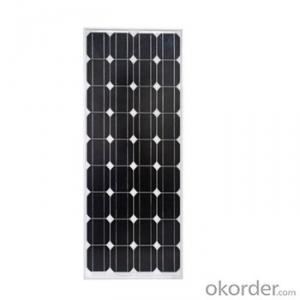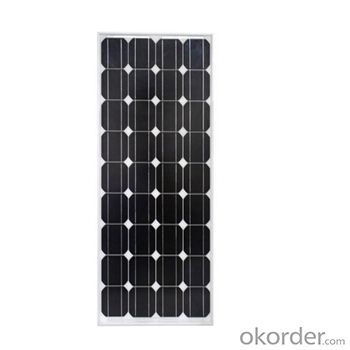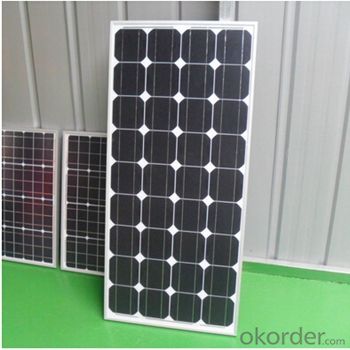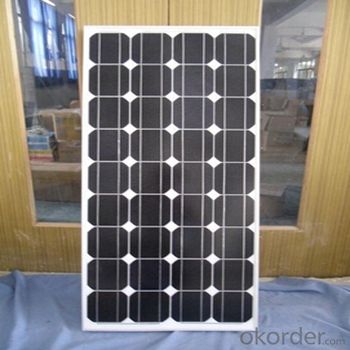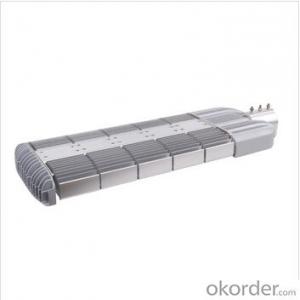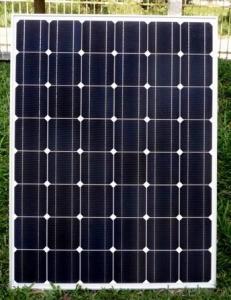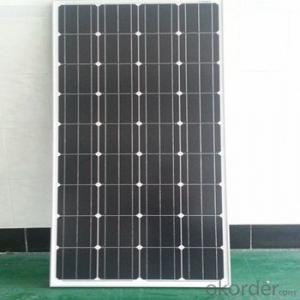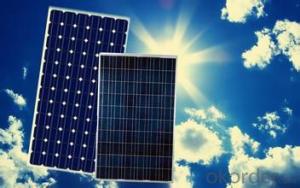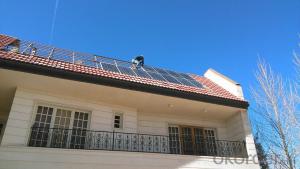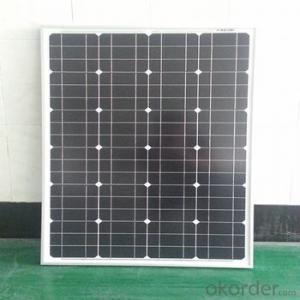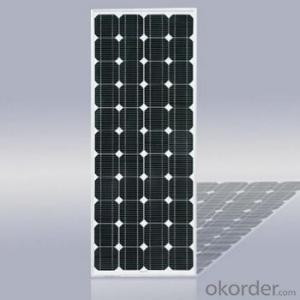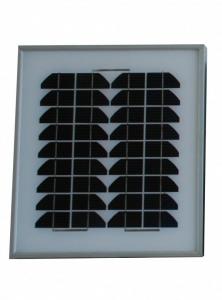Burnt Monocrystalline Solar Panels-90w CNBM Series
- Loading Port:
- Shanghai
- Payment Terms:
- TT or LC
- Min Order Qty:
- 500 pc
- Supply Capability:
- 20000 pc/month
OKorder Service Pledge
OKorder Financial Service
You Might Also Like
Monocrystalline Solar Panels 90W Series
High efficiency crystalline solar cell. Even if under the weak light, the solar module can produce maximum power output.
II Tempered glass (toughened glass): Anti-reflecting coating and high transmission rate glass increase the power output and mechanical strength of solar module.
III EVA and TPT: Using high quality EVA and TPT to prevent destroying and water.
IV AI frame: Without screw, rner connection. 6 holes on the frame can be installed easily.
V Junction box: Multi function junction box with water proof.
VI Long lifetime: ≥25 years; Less power decrease.
VII Good performance of preventing from atrocious weather such as wind and hails.
VIII Resisting moisture and etching effectively, not effected by geology.
IX The certificate issued by international authority: UL, TUV, IEC, CE.
Standard Test Conditions of Monocrystalline Silicon Solar Panel 90W Series
The opto-electrical specifications shown below are stabilized values being measured at Standard Test Conditions, Irradiance: 1000W/m2, Spectrum: AM1.5 at 25°C, The info below is subject to manufacturing tolerances.
Where appropriate minutes of measurement are available and are used for the dimensioning of the installation.
Advantages of Monocrystalline Silicon Solar Panel 90W Series
• CNBM Solar performance guarantees for 25 years
• 12 years guarantee for workmanship
• Timeliness of delivery
• Quality Products certified (TÜV, UL, CE, ISO)

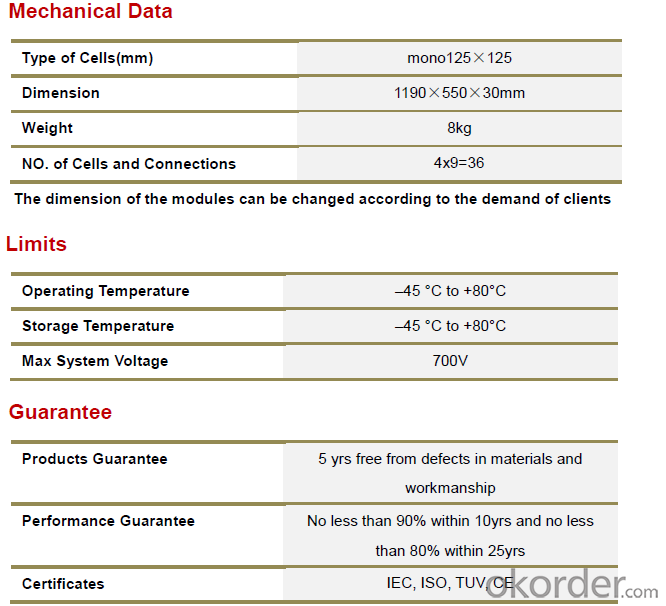
Certification of Monocrystalline Solar Panels-90w Series
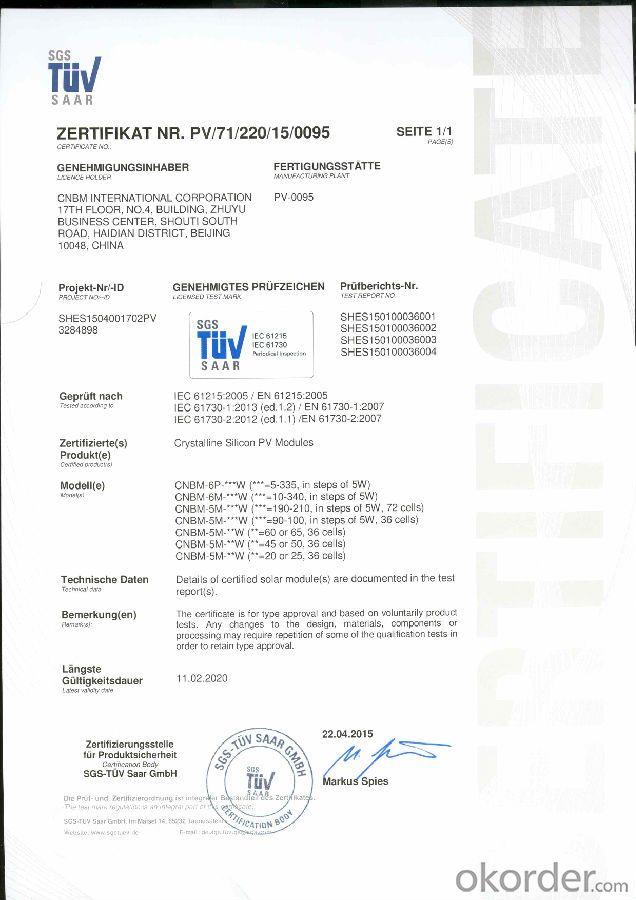
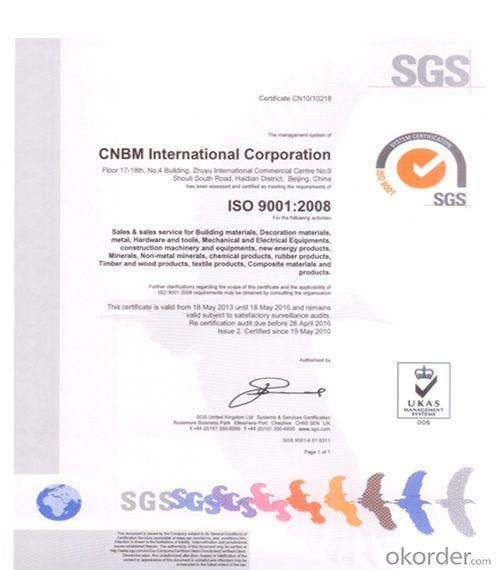
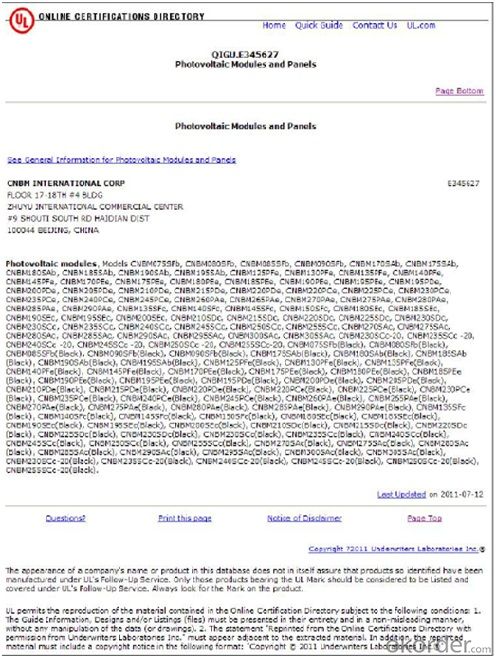
FAQ of Monocrystalline Solar Panels-90w Series
We have organized several common questions for our clients,may help you sincerely:
①What price for each watt?
It depends on the quantity, delivery date and payment terms,
②What is your size for each module? Can you tell me the Parameter of your module?
We have different series of panels in different output, both c-Si and a-Si. Please take the specification sheet for your reference.
③Can you provide the peripheral products of the solar panels, such as the battery, controller, and inverter? If so, can you tell me how do they match each other?
Yes, we can, we have two companies for solar region, one is CNBM International, the other is CNBM engineering Co.
We can provide you not only the solar module but also the off grid solar system, we can also provide you service with on grid plant.
④What is your warranty system?
Our product performance guarantees for 25 years
• 12 years guarantee for workmanship
• Timeliness of delivery
• Quality Products certified (TÜV, UL, CE, ISO)
⑤How do you pack your products?
We have rich experience on how to pack the panels to make sure the safety on shipment when it arrives at the destination.
⑥ Can you do OEM for us?
Yes, we can.
- Q: Didnt solar panels use to cost around $250,000 5 years ago?
- For just 5 years ago, certainly not! Perhaps you are thinking of 50 years ago, the kind that was put on the early communication satellites? 5 years ago, there was a glut of polysilicon, so modules were actually a little cheaper than today. Solar cell makers were basically using the scraps thrown away by chipmakers. But today, more silicon goes into making solar cells than computer chips, so that bonanza is gone. We will see prices going lower this year, possibly 20% from last year, because of improvements in technology, but also an increase in polysilicon supply, and a slowdown in demand due to worldwide recession. Later this year is a good time to buy panels, if you have the cash. The industry site below tracks module prices. They used to have more data, but I guess the old data rolls off the screen with time. If you want to see the details, they'll charge you for the report.
- Q: Please tell me what they are made of and how the materials help the solar cell produce electricity. Im doing a science projects so i need help on knowing all this info. Its a debate, so i need correct information please.I will please need more information about the bad things about solar energy and solar panels. Please say what solar panels do to create pollution or do anything that is not friendly to the environment. If you want just give me a website. Thank you
- image voltaic cells paintings for the period of the photoelectric effect. Incoming photons knock out electrons of the textile, which being a semiconductor helps a small ability distinction. close to to the sunlight, each and everything could be very severe (like a Van Halen gig), radiation, energetic ions, magnetic fields, the works. of direction, NASA project planners could take all those issues into consideration. i ask your self what textile maintains to be stable at 5800? ok (or perhaps it fairly is not needed), and captures all photons of all energies, to be one hundred% powerful. The link provided by making use of Snow Blossom is extremely thrilling. I do in simple terms no longer look waiting to study the secondary link Thermophotovoltaics. Edit: image voltaic Flares may well be a difficulty. they're by making use of and great unpredictable, upward push for hundreds of miles, achieving hundreds of thousands of Kelvin.
- Q: Solar panel packages have different levels of power. For instance you can get a kw system but is this kw per hour or day. How does this work?
- A kW is an on the spot degree of means. A kWh is a level of means produced via the years. A KW array produces an on the spot means of 000 watts. whether that could be a 2V panel which skill it produces eighty 3 amps of modern-day. In 3 hours it produces 3kWh (kilowatt hours) of electrical energy, no longer 3kW. A 3kW 2V array might produce a similar quantity of electrical energy in one hour at 079 amps.
- Q: what direction should solar panels face to get the best exposure of the sun.
- The following links is a sun angle calculator which I find very helpful during my days of doing project about solar panel. The calculator will give you the accurate location of the sun. Solar panel work best when it is directly facing the sun. All you have to do is key in your location details and it will provide you with two most important details: azimuth angle and altitude angle. Azimuth angle is the East angle where the Sun is relative to the South while altitude angle is the tilt angle of the solar panel throughout the day. By using these two angles, you will maximize your exposure of solar panels. However, if you are experiencing rainy or cloudy days, horizontally mounted solar panels is the most efficient.
- Q: If a solar panel is a .5kW system, what length of time is it putting out that much power? Every hour?
- I think it refers to the maximum power it is capable of. Of course, it won't really have this output because it's energy output (kWh) is dependent on it's energy input...
- Q: if so, would it be possible to make (or remake) an organism that could subsist off of sunlight and external heat like plants?
- It's done under the name of biodiesel. Plants capture sunlilght and produces oil, oil is used to generate movement by an engine. That can be used for transport or to generate electricity. But they can also get used more directly for solar panels: . though they aren't much good yet. Generally going to convert plant products into energy is still better. Edit: connecting a solar panel to your metabolism will remain for a long time science fiction. The traditional way of eating your food instead of absorbing it into your skin works well and can be very enjoyable.
- Q: could any tell me what type off panel is the best tube or flat and how much it should be. I live in N Ireland
- the okorder himin solar
- Q: I have a question about solar panels. What are the benefits of this system if I installed in my home. for example i know it produces electricity but does it do anything else? How many panel would you guys think I would need for 2000 sq ft. do you know if it produces hot water? Thanks for your help
- Grid-tied solar systems in the U.S. run at least $8/watt installed. To completely run a 2,000 sq ft home, you'd need about 50 amps service from solar -- both 20 volts and 240 volts. Not very practical. Panels are expensive, but the BOS (balance of system) is as well. You need mounts to bolt the panels to the roof (same thing if ground mounted). Cable, wire, and connectors will run several hundred dollars. A couple of grid-tie inverters in the range of 4,000 watts each will cost you several $6,000 to $8,000, plus sub panels, combiner boxes, breakers, disconnects, charge controls, and batteries, among other things. You'd likely need 5 to 24 panels, depending on too many factors to mention here. You'd need at least 8 batteries, likely 2 volt ones, probably more if you want to run the entire home from solar. Solar (or wind) systems have to be installed in the U.S. by state licensed installers, and there are not many of those yet. And if you grid-tie the system, you'll need to put an interconnection agreement in place with your local utility, plus the utility will have requirements on the net-metering and installation of a switch they can use to turn your solar system off from the grid. And this would not produce hot water in the way you are thinking. If you have an electric hot water heater now, the solar system could help run that, just like the rest of your home. Hot water from solar and electricity from solar are two completely different technologies.
- Q: I am doing a project for school and i need to power a 9v DC motor using a solar panel. Does anyone know places i could get these for not to expensive, and how many volts/watts i would need?
- Radio Shack.
- Q: The intensity of sunlight at the distance of the Earth's orbit is 380 W/m2. An Earth-orbiting satellite has a solar panel that measures .35 m by 4.86 m, which converts solar energy to electrical energy with an efficiency of 26%. In one hour, how much electrical energy does the panel produce? Assume that the satellite's attitude control jets keep the panel oriented perpendicular to the incoming sunlight.
- This is pretty much an exercise in knowing units and dimensional analysis. Watts are in Joules/second. So every second a square with the area(meters^2) of meter^2 receives 380 joules from the sun. In your case the square is the solar panel. So find the area of the solar panel in m^2. If you multiply area times intensity you can see that the meters cancel out and you are left with Watts(J/s). Since you want the Joules received in an hour you again multiply by how many seconds are in an hour. Leaving you with joules. What you have now is the total energy, but your solar panel is only 26% efficient, so just multiply by .26 and you will have your energy.
Send your message to us
Burnt Monocrystalline Solar Panels-90w CNBM Series
- Loading Port:
- Shanghai
- Payment Terms:
- TT or LC
- Min Order Qty:
- 500 pc
- Supply Capability:
- 20000 pc/month
OKorder Service Pledge
OKorder Financial Service
Similar products
Hot products
Hot Searches
Related keywords
